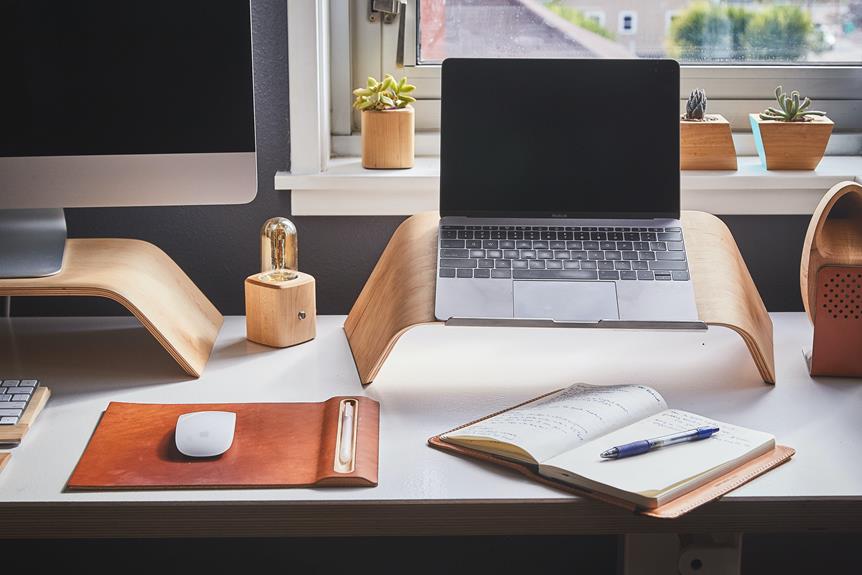So, you've finally realized that your office chair has become an extension of your body, and not in a good way. It's time to consider the benefits of a standing desk for your home office setup.
From improved posture to increased energy levels, the advantages are numerous. But before you start envisioning yourself as a productivity powerhouse, there are a few things you need to consider. Are standing desks worth the hype? And how can you make the transition without feeling like a newborn giraffe?
Keep reading to uncover the answers.
Key Takeaways
- Standing desks can provide numerous health benefits, including reducing the risk of sedentary-related health issues, lowering blood sugar levels, decreasing the risk of heart disease, and reducing back and neck pain.
- Proper ergonomics and posture improvement techniques should be implemented, such as adjusting desk height, using an anti-fatigue mat, using a footrest, and adjusting monitor height to eye level.
- Taking regular sitting breaks, incorporating movement breaks like brisk walks or stretching exercises, and alternating between sitting and standing can increase energy and productivity.
- When choosing a standing desk, factors to consider include adjustable height options, workspace organization, sturdiness and stability, and ease of transition between sitting and standing positions.
Health Benefits of Standing Desks
Standing desks offer several health benefits, including reducing the risk of sedentary-related health issues such as obesity and cardiovascular disease. Research has shown that prolonged sitting can lead to various health problems.
Standing desk alternatives, such as adjustable desks or treadmill desks, have been gaining attention due to the potential health benefits they offer. Studies have indicated that using a standing desk can help lower blood sugar levels, decrease the risk of heart disease, and reduce back and neck pain associated with prolonged sitting.
Recent standing desk research has also suggested that standing can increase energy expenditure and improve posture, leading to potential long-term health benefits. Standing desk alternatives, such as standing mats and footrests, can further enhance the ergonomic benefits of using a standing desk. These alternatives can help reduce discomfort and fatigue associated with prolonged standing, making the transition to a standing desk more comfortable.
Additionally, standing desk research has found that standing may also boost productivity and cognitive function. Alternating between sitting and standing throughout the workday has been linked to improved focus and mental clarity.
While standing for extended periods may not be suitable for everyone, incorporating standing desk alternatives and taking regular breaks to move and stretch can help mitigate any potential discomfort while reaping the health benefits of using a standing desk.
Ergonomics and Posture Improvement
To improve your posture and ensure ergonomic comfort while using a standing desk, consider adjusting the desk height to align with your elbows at a 90-degree angle when typing. This simple adjustment can make a significant difference in your work posture and overall comfort.
Here are some additional tips to help you optimize your standing desk setup:
- Invest in an anti-fatigue mat: Standing for long periods can put strain on your feet and lower back. An anti-fatigue mat provides cushioning and support, reducing discomfort and fatigue.
- Use a footrest: A footrest can help alleviate pressure on your lower back and feet, promoting better posture and circulation.
- Adjust monitor height: Position your monitor at eye level to prevent neck strain. This can be achieved by using a monitor stand or adjusting the desk and monitor height accordingly.
- Take sitting breaks: While the aim is to stand more, it's important to find a balance. Consider incorporating a tall stool or chair to take sitting breaks when needed. Alternating between sitting and standing can help reduce muscle fatigue and improve overall comfort.
Increased Energy and Productivity
Boost your energy and productivity by incorporating short movement breaks and stretching exercises into your standing desk routine. By integrating these simple activities, you can experience improved focus and reduced fatigue throughout your workday. Here's a quick guide to help you seamlessly infuse movement and stretching into your home office setup:
| Movement Breaks | Stretching Exercises |
|---|---|
| Take a brisk 5-minute walk | Neck and shoulder rolls |
| Do a set of jumping jacks | Standing forward bend |
| Climb a flight of stairs | Hip flexor stretch |
| Dance to your favorite song | Calf and hamstring stretch |
Engaging in short movement breaks, such as a brisk walk or a set of jumping jacks, can help increase blood circulation, elevate energy levels, and combat the midday slump. Likewise, incorporating stretching exercises like neck and shoulder rolls, standing forward bends, and hip flexor stretches can alleviate muscle tension, enhance flexibility, and reduce feelings of fatigue. These activities not only re-energize your body but also sharpen your focus, leading to improved productivity and efficiency in your work.
Choosing the Right Standing Desk
Incorporating movement breaks and stretching exercises into your routine can be further enhanced by selecting the right standing desk for your home office. Here are four key factors to consider when choosing the right standing desk:
- Adjustable Height: Look for a standing desk that offers adjustable height options. This feature allows you to customize the desk to your preferred standing height, promoting proper posture and reducing strain on your body.
- Workspace Organization: Consider the organization and layout of the desk's surface. Look for a standing desk with ample space for your computer, paperwork, and any other necessary items. Built-in storage or cable management features can help keep your workspace tidy and efficient.
- Sturdiness and Stability: Prioritize a standing desk that's sturdy and stable. This will ensure that the desk can support your work equipment without wobbling or shaking, providing a reliable foundation for your tasks.
- Ease of Transition: Opt for a standing desk that allows for smooth and easy transition between sitting and standing positions. This will make it convenient for you to switch postures throughout the day, promoting movement and reducing prolonged periods of sitting.
Tips for Transitioning to a Standing Desk
Transitioning to a standing desk may require some initial adjustments to your work routine and posture, but with a few simple tips, you can make the switch smoothly and comfortably.
Firstly, ensure your standing desk setup is ergonomic. Position the desk and monitor at the right height so that your screen is at eye level, and your arms are at a 90-degree angle when typing. This will help prevent strain on your neck, shoulders, and wrists.
Additionally, it's essential to wear comfortable, supportive shoes and use an anti-fatigue mat to reduce the impact on your feet and lower body. It's also crucial to alternate between sitting and standing to avoid standing desk fatigue. Start gradually by standing for 20-30 minutes every hour and then slowly increasing standing time as your body adjusts. Remember to listen to your body and take breaks when needed.
To maintain good posture, stand tall with your shoulders relaxed and your weight evenly distributed between both feet. Avoid locking your knees and try to engage your core muscles. A good tip is to use a footrest periodically to shift your weight and ease any pressure on your legs and lower back.
Lastly, remember to stay hydrated and take regular stretch breaks to keep your body limber and reduce any muscle stiffness. With these tips, transitioning to a standing desk can be a positive and comfortable experience.
Standing Desk Accessories and Add-ons
Ready to take your standing desk setup to the next level?
Consider adding an ergonomic mat to reduce fatigue and improve comfort.
You can also explore monitor arm options to customize the height and angle of your screen.
Additionally, look into cable management solutions to keep your workspace tidy and organized.
Ergonomic Mat Benefits
Consider adding an ergonomic mat to your standing desk setup for improved comfort and support while standing. Here are four benefits of using an anti-fatigue mat:
- Reduced Fatigue: The cushioned surface of an ergonomic mat helps to reduce strain on your feet and legs, minimizing fatigue during prolonged standing.
- Improved Circulation: Standing on a supportive mat encourages subtle movements, which can improve blood circulation and reduce the risk of varicose veins.
- Joint Relief: The cushioning provided by the mat eases pressure on your joints, offering relief from discomfort associated with standing for extended periods.
- Posture Support: An ergonomic mat promotes better posture by encouraging slight movements that engage core muscles, reducing the risk of slouching and back pain.
Investing in an ergonomic mat can significantly enhance your standing desk experience, promoting better comfort and overall well-being.
Monitor Arm Options
When selecting a monitor arm for your standing desk, consider the range of motion and flexibility it offers to optimize your workspace. Look for adjustable height options that allow you to position the monitor at eye level, reducing neck strain.
A good monitor arm should also provide workspace organization by managing cables and keeping them out of sight. This helps create a clean and clutter-free environment, enhancing productivity.
Additionally, monitor arms with easy-to-adjust features enable you to reposition the screen quickly, accommodating changes in posture throughout the day. Prioritize a monitor arm that offers smooth and effortless monitor placement adjustments, allowing you to switch between sitting and standing positions seamlessly.
Cable Management Solutions
To streamline your workspace and maintain a clutter-free environment, consider incorporating cable management solutions as standing desk accessories and add-ons.
Here are four cable management solutions to optimize your workspace:
- Under-Desk Cable Trays: Maximize space by keeping cables neatly organized and out of sight underneath your desk.
- Cable Clips and Ties: Keep cables secured and visually appealing with these simple yet effective solutions.
- Cable Raceways: Conceal cables along the walls or under the desk, enhancing both cable organization and aesthetics.
- Cable Management Boxes: Hide power strips and excess cables in sleek, minimalist boxes to keep your workspace looking tidy and professional.
Implementing these cable management solutions won't only save space but also enhance the visual appeal of your home office setup.
Frequently Asked Questions
Are Standing Desks Suitable for People With Certain Medical Conditions, Such as Back Problems or Circulation Issues?
If you have back problems or circulation issues, standing desks might not be suitable. They could worsen your condition without proper support. Ensure you have adequate back support and wear ergonomic footwear to minimize strain.
Can Standing Desks Be Easily Adjusted for Different Heights and Preferences?
Yes, standing desks can be easily adjusted for different heights and preferences. They offer adjustable stability and ergonomic accessories to ensure comfort and support. This flexibility allows you to customize your workspace to suit your needs.
Are There Any Specific Exercises or Stretches Recommended for Those Using Standing Desks?
To prevent fatigue and discomfort when using a standing desk, consider wearing ergonomic footwear and making sure your workstation ergonomics are optimal. Regularly correct your posture and perform upper body stretches to reduce tension and improve circulation.
What Are Some Common Mistakes to Avoid When Transitioning to a Standing Desk?
When transitioning to a standing desk, beware of common pitfalls like poor posture or standing for too long. Proper footwear and an ergonomic setup are essential. Focus on aligning your spine and engaging your core.
Are There Any Recommended Accessories or Add-Ons for Standing Desks to Enhance Their Functionality?
To enhance your standing desk's functionality, consider accessories like monitor arms, anti-fatigue mats, and cable management solutions. These add-ons can improve ergonomics, boost productivity, and enhance workspace organization, providing numerous benefits for your home office.



